Cena de caracteres na épica arcaica e na tragédia grega clássica
DOI:
https://doi.org/10.1590/1517-106X/2017193510524Abstract
Este artigo investigou o uso de uma técnica narrativa presente na épica homérica e na tragédia Ifigênia em Áulis, de Eurípides, a fim de demonstrar os efeitos produzidos por tal expediente. O resultado da investigação apontou não só a diferença entre os níveis narrativos épico e trágico, mas também a produção de um quadro narrativo específico em ambas narrativas: a cena de caracteres.
References
ARISTOTE. Poétique. Texte établi et traduit par J. Hardy. Paris: Les Belles Lettres, 2002.
BOLÉO, Manuel de Paiva. O bucolismo de Teócrito e Vergílio. Coimbra: Biblioteca da universidade, 1936.
CURTIUS, Ernest R. Literatura europeia e idade média latina. Rio de Janeiro: Instituto Nacional do Livro, 1957.
EURIPIDES. Euripidis fabulae: Iphigenia Aulidensis, ed. J. Diggle, vol. 3. Oxford: Clarendon Press, 1994.
GENETTE, G. Figuras II. Trad. Nícia Adan Bonatti. São Paulo: Estação Liberdade, 2015.
GOWARD, Barbara. Telling Tragedy: narrative technique in Aeschylus, Sophocles and Euripides. London: Gerald Duckworth & Co. Ltd, 1999.
HALLIWELL, Stephen. Aristotle´s Poetics. Chicago, fte University Chicago Press, 1998.
HOMERO. Iliada. Texto critico, traducción y notas por Luis M. Macía Aparicio. Vol. I, II, III y IV. Madrid: CSIC, 2007.
HOMERO. Odyssea. ed. P. von der Momerum. Helbing & Lichtenhahn, 1962. JONG, Irene J. F. de. Narrative in Drama: fte Art of the Euripidean Messenger Speech. Leiden: Brill, 1991.
KLAUS, Peter. Description and Event in Narrative. Copenhagen: Orbis Litterarum, 1982, 37, 201-216.
PLATO. La République. ed. bilingue. Trad. É. Chambry. Paris: Belles Lettres, 1934.
SCHMID, Wolf. Narratology: an introduction. New York: Walter de Gruyter GmbH & Co. KG, 2010.
WILLCOCK, Malcolm M. A companion to the Iliad. Chicago: University of Chicago Press, 1976.
Downloads
Published
Issue
Section
License
THE AUTHOR/S confirm/s his, her or their participation in all stages of work preparation: 1) Conception, project, bibliographical research, analysis and interpretation of data; 2) Writing and reviewing the manuscript; 3) Approval of the final version of the manuscript for publication; 4) Responsibility for all aspects of the work and guarantee for the accuracy and integrity of any part of the work. The submission of works implies the immediate cession, without onus, by all authors, of publication rights to the journal Alea, licensed under CC BY (https://creativecommons.org/licenses/by/4.0/). The authors are fully responsible for the content of the article and continue to hold all copyrights for subsequent publications of it, and should, if possible, include the reference to the first publication in the journal. Alea does not commit to returning received contributions. Authors of articles, reviews or translations will receive a copy of the journal.

